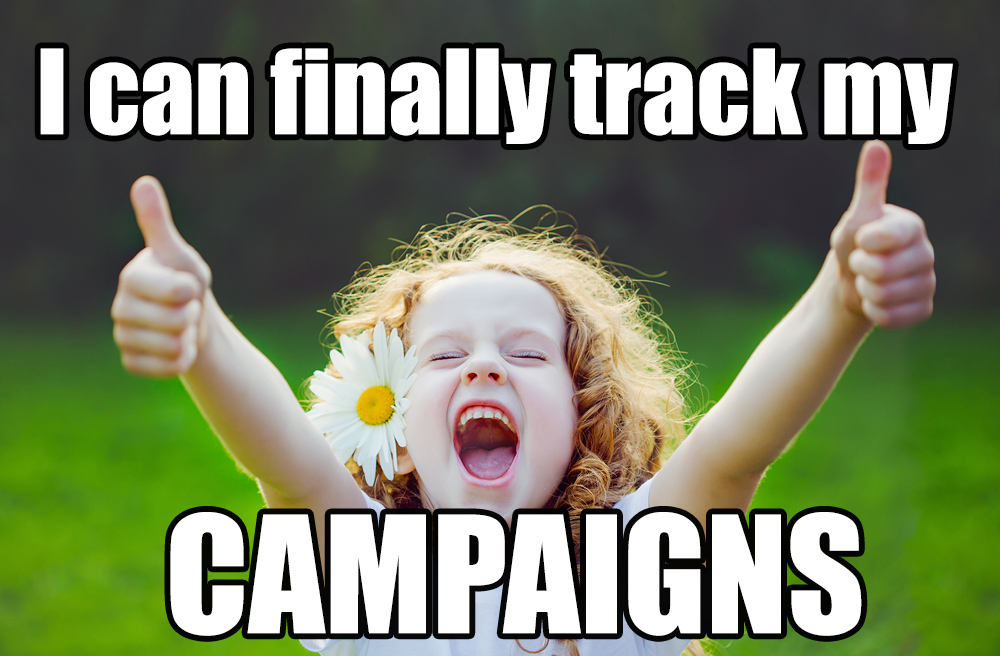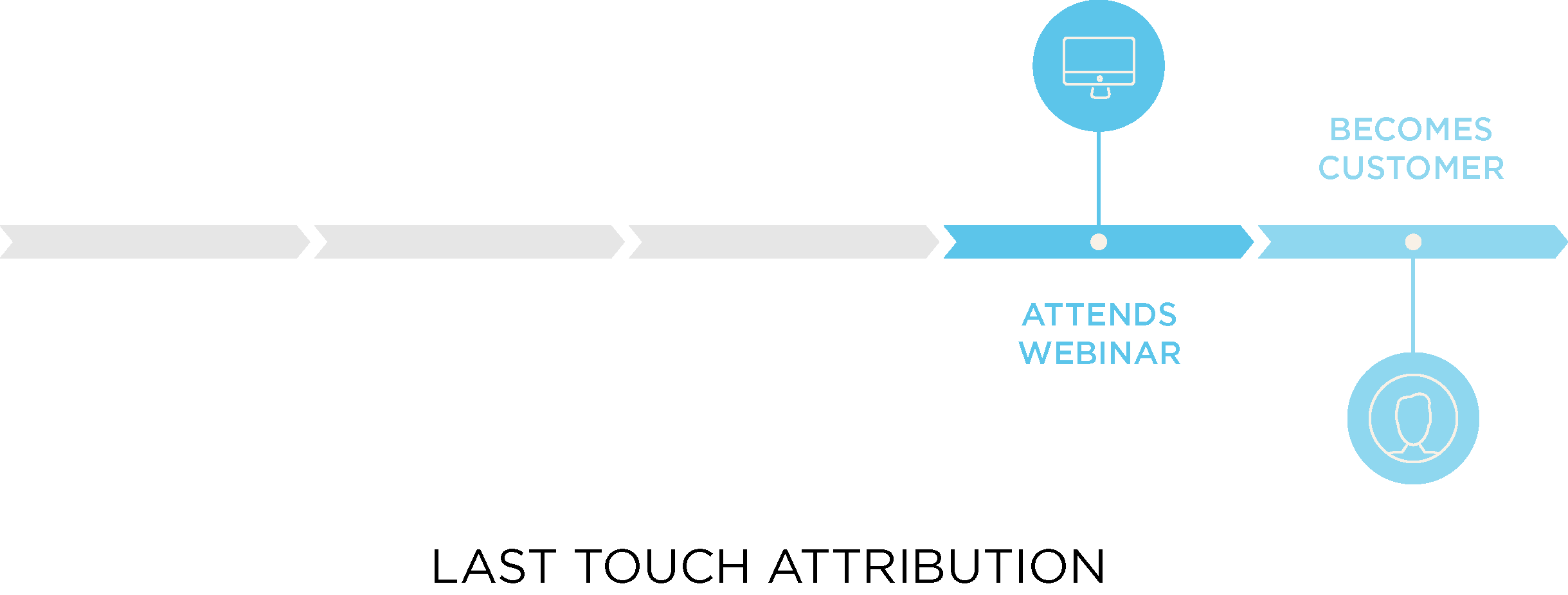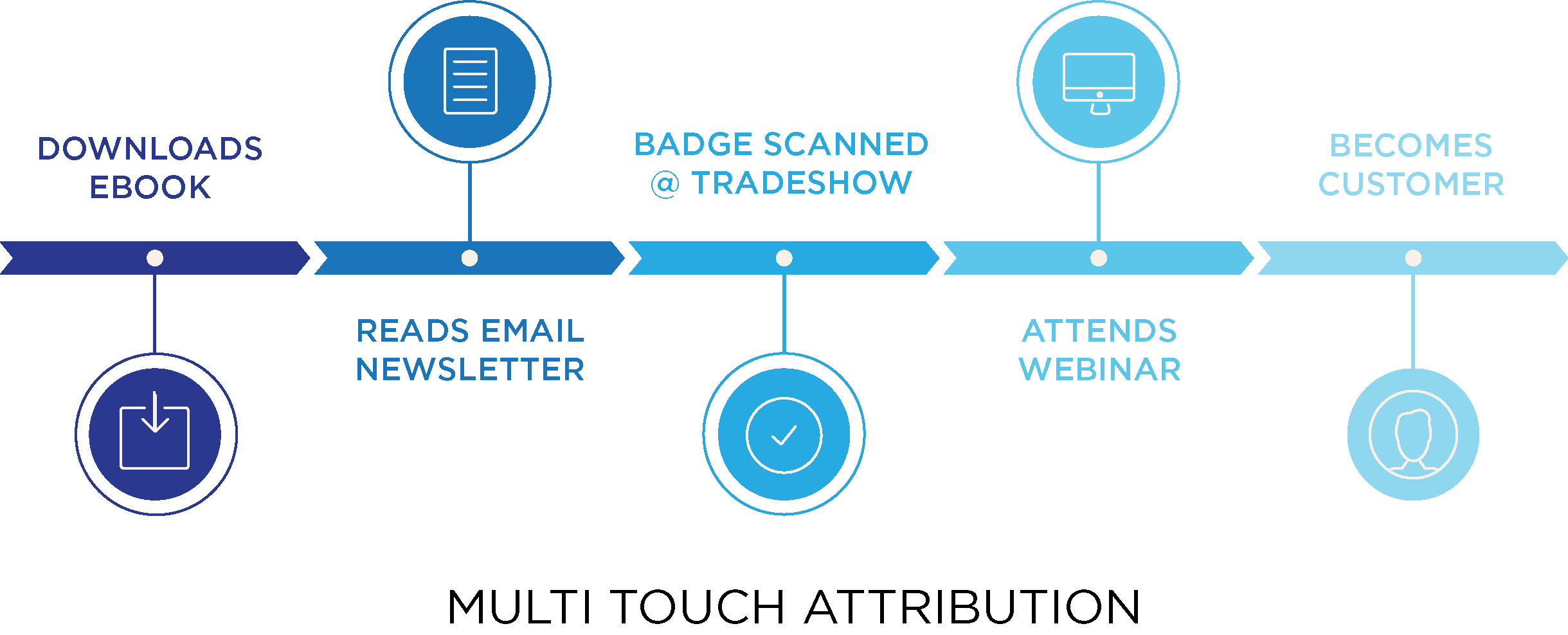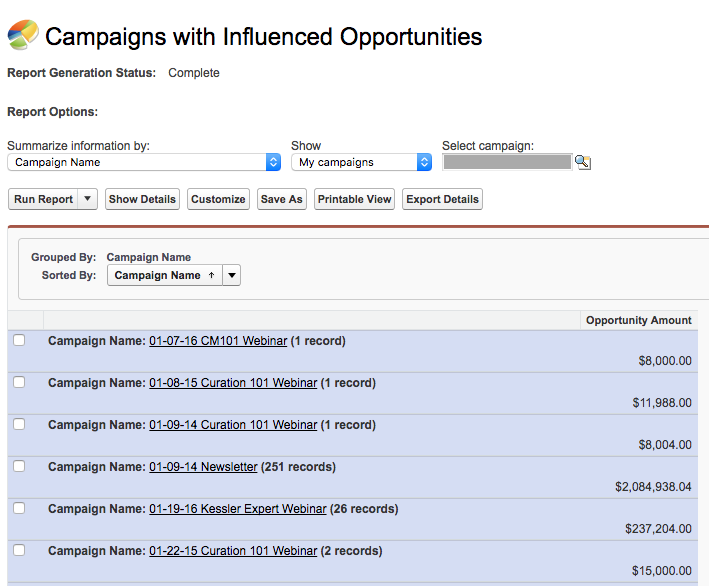- Share Salesforce Campaign Influence: How to & Best Practices on Facebook
- Share Salesforce Campaign Influence: How to & Best Practices on Twitter
- Share Salesforce Campaign Influence: How to & Best Practices on Linkedin
- Share Salesforce Campaign Influence: How to & Best Practices via email
 One of the more powerful features in Salesforce for metrics-oriented marketers is the Campaigns functionality. With Salesforce Campaign Influence, you can effectively track the impact of a marketing campaign throughout the larger portion of the sales funnel, starting with a Lead all the way through to a closed Opportunity.
One of the more powerful features in Salesforce for metrics-oriented marketers is the Campaigns functionality. With Salesforce Campaign Influence, you can effectively track the impact of a marketing campaign throughout the larger portion of the sales funnel, starting with a Lead all the way through to a closed Opportunity.
What is Salesforce Campaign Influence?
Salesforce campaign influence allows you to associate an Opportunity to multiple campaigns. Campaigns are essentially many-to-many mappings between a Campaign object in Salesforce, and the Leads, Opportunities, or Contacts that are members of the campaign. Campaign tracking is available in the following editions of Salesforce:
- Professional
- Enterprise
- Performance
- Unlimited
- Developer
Salesforce Campaign Influence can track how various marketing and sales initiatives have performed from the mid-to-bottom of the funnel. For example, you can use campaign tracking to see how a print, direct mail, pay-per-click, trade show, content marketing, or cold calling campaign performed in terms of the leads, opportunities, and revenue it generated or influenced.
What are the benefits of Salesforce Campaign Influence?
Salesforce Campaign Influence has a few key benefits over other ways of tracking campaign performance.
Persistent Tracking Through Multiple Object Types
Salesforce Campaign Influence can be associated with multiple native object types in Salesforce including Leads, Contacts, and Opportunities. As a result, you can associate Salesforce Campaign Influence with a Lead record, and as it progresses in the sales process and is converted into a Contact and Opportunity record, the Campaign continues to be associated with the new object types.
Using this a marketer can find out not only how many leads a particular campaign influenced, but also the amount of sales pipeline that was influenced, generated, and ultimately won due to the campaign.
Multiple Campaign Influence
Campaign tracking is implemented using what is known in database schema design as a many-to-many relationship. Essentially, multiple leads/opportunities/contacts/accounts can be associated with multiple campaigns.
Because of this relationship, you can effectively track how a single opportunity was influenced by multiple campaigns over its lifetime.
When should Salesforce Campaign Tracking be used?
Salesforce campaign tracking can be used for several distinct use cases.
Content Marketing Campaign Measurement
Campaign tracking is a powerful way to measure the effectiveness of an inbound marketing campaign. For example, Salesforce Campaign influence can be created for a particular content asset, such as a gated eBook. Every time a lead fills out the form to download and read the eBook, a trigger is activated in your Marketing Automation Platform (such as Eloqua, Marketo, Pardot or Act-On) to add the lead as a member of the campaign associated with that eBook. As the lead progresses through the funnel over time, you can then look back and compute the ROI of the eBook by seeing how many leads, sales pipeline, and revenue was influenced by it.
Examples of such campaigns include:
- eBooks
- Case studies
- Email newsletter sign ups
- Any gated content
- Event Marketing Measurement
For offline events such as proprietary trade shows or conferences, and online events such as virtual conferences or webinars, Salesforce Campaign tracking can also measure the return on your investment.

Offline Events
For offline events, you will likely upload a list from either the conference itself through badge scans, or from your sales team collecting business cards. When uploading the list, you can create a marketing campaign for the event, and add all uploaded leads as members of the new campaign.
Examples of offline events that can be tracked:
- Conference lists (provided by organizers to sponsors)
- Booth badge scans (at sponsor booths)
- Business cards (collected by sales team at networking events)
- Talk attendee badge scans
- Online Events
For an online event such as a webinar or virtual conference, you can set your Marketing Automation Platform to automatically add leads as members of a marketing campaign for the event when they register for it.
Again, as leads progress through the funnel, you can retrospectively understand the result in terms of opportunities from that event.
Sales Prospecting
Salesforce Campaign Influence is also great at tracking how effective a sales prospecting campaign has been. In these cases, a list of leads is added as members of a campaign created for the prospecting outreach. Then as the sales team calls into this list of leads, the outcomes (opportunities) resulting from this outreach can be followed using the Campaign object.
Direct Mail
You can also use Salesforce Campaigns for direct mail campaigns, often coupled with a sales follow up. In this case, you send direct mail to a segment of leads who are all added as members of a marketing campaign that represents the direct mail initiative.

If, for example, a direct mail has a call-to-action to a landing page specifically for the campaign, then as leads fill out the form or enter the promo code on that landing page, the marketing automation system can be set up to update the campaign membership in Salesforce to denote which members of the campaign responded to the direct mail.
Using this approach, you can not only measure the opportunities resulting from the marketing campaign, but also the response rate of the direct mail creative in the first place.
How to set Them Up
In Salesforce
To set up a campaign in Salesforce, head over to the Campaigns tab, and click the “New” button to create a new marketing campaign.
Campaign Fields
Here you’ll see a bunch of fields that need to be filled in. In particular two of the important fields are:
Campaign Name: It’s easy to get into a state of disarray with arbitrary naming conventions. My recommendation is to use the following format: TypeOfCampaign_NameOfCampaign_MonthYear. For example, the name of any leads collected at the SiriusDecisions Summit 2016 would be: InPersonEvent_SiriusDecisionsSummit2016_May2016.
Type: Have at most a dozen campaign types. Examples of what to populate this field with include: Email, List Purchase, Ad, Direct Mail, Gated Content, In-Person Event, Digital Event, Organic Referral, Organic Search, Paid Search, Teleprospecting Generated Lead (TGL).
Advanced Setup & Member Status Values
You can define the member status values for the campaign under “Advanced Setup.” As you add leads and contacts as members of the campaign, these values indicate the status of that membership. Here are a few examples of how to utilize member status values for each of the following types of campaigns:
- Webinars: Registered, Attended, Viewed Recording
- Email: Sent, Opened, Clicked
- In Person Event (Trade show): Registered at Conference, Visited Booth, Saw Demo
- Paid Search Ad: Clicked Ad, Filled Form
Member status values help you to easily measure the sub-funnel response rate for a marketing campaign.
Populating Members
In Eloqua
The fastest way to add members to a Salesforce Campaign through Eloqua is to add a step to your program in the Campaign Canvas. You can create the campaign in Salesforce first, or have Eloqua add the new campaign automatically—a nice convenience. Upon activating an Eloqua Campaign, as members flow through your Campaign Canvas and hit the “Add to Campaign” flow step, they’re automatically added to the corresponding Salesforce Campaign. Don’t forget to set a Salesforce Campaign Member Status (Responded, Converted, Registered, Attended, etc) as well. Everything updated in Eloqua will carry over and be mirrored in your Salesforce campaign.
In Marketo
The best way to add members to a Salesforce Campaign Influence through Marketo is to sync your Salesforce Campaign with a Program. When you create a Marketo Program for your campaign, be it content, events, or direct mail, click Program Actions and select Salesforce Campaign Sync. From here, you can create a new Salesforce Campaign (recommended) or sync to an existing Salesforce Campaign.
If you are selecting an existing Salesforce Campaign, match the statuses of the Salesforce Campaign and the Marketo Program.
Now, when you add members to the Marketo Program through triggers or list uploads, it is mirrored in the Salesforce Campaign.
Prerequisite: You must Enable Salesforce Campaign Sync in your Marketo instance. Have your Marketo administrator go to the Salesforce section of the Admin menu, click Edit Sync Setting, and check Enable Salesforce Campaign Sync. Now you’re good to go!
Don’t want to sync your Salesforce Campaign with Programs? You can also use the Add to SFDC Campaign or Change Status in SFDC Campaign flow steps in Smart Campaigns to add members based on triggers or list membership. It’s less elegant though.
In Pardot
Pardot cannot create Salesforce Campaigns, but after you create a campaign in Salesforce, Pardot can add prospects to those campaigns. Using automation rules, segmentation rules, completion actions, or drip and engagement programs, you can add prospects to your Salesforce Campaign. After you set up your rule, drip, or completion action, you will see the action criteria “Add to Salesforce Campaign.” You can select which marketing campaign the prospect should be added to, as well as the campaign status.
Adding a prospect to a Salesforce Campaign through Pardot won’t create a new Lead in Salesforce. You need to push prospects over through assignment to a User, Queue, or Group. If you choose not to push new prospects over right away, Pardot will store the campaign information and sync it to Salesforce when the prospect is pushed over.
Only Salesforce Campaigns marked as Active will be available in Pardot.
Attribution & Salesforce Campaigns
One of the confusing aspects of campaigns revolves around attribution. Do you give credit to the campaign that initially generated the lead? Do you give credit to the campaign the lead responded to before they became an opportunity? Or do you give credit to the campaign which influenced the lead right before the deal was won?
Another way of thinking about this is to ask yourself who gets credit for your college diploma? Is it:
- Your kindergarten teacher?
- Your high school teacher?
- Or your college professor?
Assigning attribution is one of the trickiest, and most philosophically contested areas of marketing. There are four dominant models (first touch, last touch, multitouch and weighted multitouch) that are used by marketing to assign attribution which are described below.
To understand these models, let’s consider an example of a buyer’s journey:
First Touch Attribution Model
In first touch attribution, all credit for a lead is given to the “first touch” taken by a lead. For example, if a lead is initially generated by filling out a form to download an eBook, that eBook gets complete credit for the sale.
Pros: It’s very easy to implement. All that’s required is to tag a lead on their first interaction in a Salesforce Custom Field on the Lead object, and then preserve that Field as the Lead is converted into a Contact and then Opportunity.
Cons: First touch models do not account for any further interactions by the buyer. In the example above, the newsletter, trade show, and webinar get zero credit for the purchase.
When to Use It: First touch attribution is great for:
- Businesses that have an extremely short sales cycle with typically a single interaction with the customer. For example, tracking which advertisements lead to e-commerce purchases.
- Gauging which sources are generating or driving leads, even for businesses that have longer sales cycles.
Last Touch Attribution Model
In this example, a last touch attribution model gives all credit for the sale to the webinar.
Pros: This model is also relatively easy to implement. Create a Salesforce Custom Field on a Lead or Contact record which records the last interaction by a prospect. Every time a new interaction happens, this field is overwritten until the end of the buying process, so that you end up storing the last interaction before the customer made a purchase decision.
Cons: It does not account for any prior interactions. As a result, this model cannot reveal insights on whether a particular marketing campaign or marketing channels is generating leads or interest.
When to Use It: Last touch attribution is effective at evaluating the bottom-of-the-funnel (BOFU) campaigns and tactics influencing a purchase decision. For example, last touch attribution can reveal which sales enablement content is most effective at pushing someone over the tipping point to a purchase, which first touch attribution cannot do.
Multi-touch Attribution Model
Multi-touch attribution gives credit to all interactions and touchpoints of a buyer throughout the sales cycle. In this example, an eBook, newsletter, badge scan at a trade show, and a webinar all receive equal credit for the sale.
Pros: Multi-touch attribution models can effectively capture all interactions, thereby giving fair credit to anything that influenced a buyer.
Cons: Multi-touch attribution models add a lot of complexity. They are tricky to implement because they require Salesforce Campaign tracking to be set up. They are also harder to understand and analyze because it’s not easy to say what should get credit for a sale.
When to Use It: Multi-touch models are ideal for sales processes that extend over a period of time and have many buyer interactions. They are usually associated with a research process undertaken by a buyer. Such sales processes are known as “considered purchases” because the buyer must carefully make a decision over a period of time, rather than an impulsive decision, thereby increasing the number of touchpoints.
Weighted Multi-touch Attribution Model
Rather than giving equal credit to all interactions (à la multi-touch attribution), a marketer can assign different weights to different interactions, using many methodologies to assign weights. In the example below, the marketer has given greater credit to the first touch and last touch, and less credit to the intermediary touch points.
Pros: Such models can capture all interactions, but also share attributes with first and last touch attribution models, because they can give greater weight to the first and last touches.
Cons: These models are extremely complex to implement. Not only do you have to implement campaign tracking, but you then have to implement a weighted algorithm on top of that—which requires custom software development or more advanced Salesforce add-ons.
It’s also not obvious what a weighting model should be. In the example above, the marketer has decided to give more weight to the first and last interaction, and less to the ones in the middle. But exactly how much weight should be given to the first and last interactions? Such a model can also be misleading, because perhaps one of the middle touchpoints—such as the meeting at the trade show—was actually the most important interaction, yet it receives less weight than the webinar.
Lastly, a weighted multi-touch attribution model results in hard to interpret numbers when it comes to reporting. These models may report that webinars result in .41 opportunities rather easy to digest whole numbers.
When to use it: This model is worth considering when you have an extended sales process, but also feel the need to capture elements of first and last touch modeling as well.
Reporting With Campaigns and Salesforce
Salesforce
Prerequisite: You will need to enable Campaign Influence. Your System Administrator will need to log a case with Salesforce Support. You can find full instructions here.
Once you have Campaign Influence enabled in your Salesforce Influence, you can pull a number of interesting reports. Under the Campaigns folder in your Reports menu, you will now see the report type “Campaigns with Influence.” Campaign Influence in Salesforce tracks pipeline and revenue for multiple campaigns and ties all campaign membership of a contact associated with an opportunity to that opportunity. You can slice and dice by Campaign Type, Campaign Name, Response, Status, Time Frame, and more.
Non-Salesforce Options
Out of the box, Salesforce Campaign Influence reporting lacks the ability for more advanced attribution models. Many use other tools such as FullCircle Insights, Brightfunnel, InsightSquared and Marketo’s Revenue Cycle Engine to get a better view of campaign influence.
Remember, Salesforce Campaign Influence can only look at contacts associated with an Opportunity, so if your sales team isn’t diligent about adding people, the data can be incomplete.
Where Campaigns Fall Short
Only From Leads Onwards
Campaign Influence tracking is implemented in Salesforce, so it’s necessarily limited by Salesforce’s worldview. Salesforce was designed for sales first and foremost, so the buyer journey in Salesforce starts off when a Lead is created. Campaign tracking is very effective at measuring influence on leads and opportunities. But campaign tracking is wholly unable to ascertain the influence a marketing campaign has before a buyer becomes a lead—when they are just a “suspect.”
Why this matters: Given the easy access we now have to consumer information on the Internet, many analyst firms have said that the majority of a prospective buyer’s decision-making process—perhaps 70 percent—happens before they ever fill out their first form or speak to a sales person. This means Salesforce campaign tracking is only capable of tracking campaign influence after the majority of the buyer journey has already been completed.
Typically Only Gated Content
Campaign tracking requires that each member of a campaign is a lead, so when it comes to measuring content marketing, campaigns are typically only utilized for gated content, or content such as whitepapers that are behind a form. This ensures that anyone consuming content is already a lead in the CRM system, because they have already filled out a form.
Why this matters: Measuring only the influence of gated content misses most of the picture. The majority of what’s produced by a content marketing team is ungated, such as blog posts, social media interactions, and infographics. Similarly, the majority of content a prospect consumes is ungated as well.
Doesn’t Scale
Campaign tracking works well when implemented, but it does need to be implemented. And setting up a campaign is non-trivial. It requires creating a campaign in Salesforce, configuring its fields and response values, setting up corresponding triggers to add members to it in the marketing automation platform, and finally—testing it.
Why this matters: Because setting up a Salesforce Campaign Influence is onerous, they are only used sparingly, for select initiatives. They do not scale down to smaller marketing initiatives or smaller content items that may be produced on a more regular basis.
Siloed Data
While the performance data of a Salesforce Campaign Influence is readily available with campaign tracking, the associated campaign metadata is often stored in other adjacent systems.
Why this matters: Having campaign performance data alongside other campaign metadata enables you to perform powerful analysis on the effectiveness of various marketing techniques.
For example, combining a content marketing editorial calendar with campaign influence data on various content campaigns enables a marketer to ask and answer questions such as:
- Which content formats work best at each stage of the funnel?
- Which content writers produce the most opportunity pipeline?
- For which content personas am I the most effective at generating revenue?
Similarly, the combination of an event marketing calendar and campaign influence data can answer questions such as:
- Which salespeople should we staff at each conference?
- On average, do conferences on the West or East Coast perform better?
Beyond Campaigns
Campaigns are obviously powerful mechanisms for measuring the ROI of many marketing activities throughout the sales and marketing funnel. But, there are many drawbacks with campaigns that preclude them from measuring the effectiveness of content marketing as a whole.
In order to accurately and comprehensively measure content marketing, we need a means that goes beyond campaigns and exhibits the following properties:
- Captures all interactions through the funnel.
- Captures interactions with all content—not just gated content.
- Has little or no set-up in the CRM in Marketing Automation to begin tracking.
- Scales to thousands of pieces of content or possible interaction points.
- Integrates with other data siloes—CRM, MAP, Social, CMS, Editorial Calendar, Web Analytics.
Most modern marketing organizations already have all the data they need to track the effectiveness of content marketing, but the data is siloed in several systems.
To comprehensively understand every content interaction for anyone at any stage in the journey, we need a data-centric content marketing platform. Such a platform brings this data together into a single data warehouse, and can then break down the content by multiple different views and attributes to provide clear insight into marketing performance.
Examples of questions that can be answered by a content marketing platform combining all this data include:
- What is the total value of all opportunities my (ungated) infographic helped generate?
- Which blog post drives the most Google search traffic, and ultimately results in revenue?
- What are the most popular content topics consumed by director-level employees at a specific named account?
- Which content interactions resulted in a closed won opportunity?
- Which content most heavily influences the renewal opportunities of my SaaS product?
- Which content accelerates the sales cycle the most? Which protracts it the most?
- Across the thousands of pieces of content we’ve ever published, what’s their overall influence of revenue?
For data-oriented marketers looking to get the most out of Salesforce, you should now have the ability to effectively track the impact of a content marketing campaign, the impact of either an online and offline event marketing campaign—whether for proprietary trade shows, conferences, virtual conferences or webinars—and direct mail and sales prospecting campaigns throughout the majority of the sales funnel.
However, Salesforce Campaign Influence can’t measure ungated content, which by current consensus, accounts for roughly two thirds of a buyer’s journey online. Select content marketing platforms—such as Curata CMP—can. For a deep overview of best practices for analyzing and measuring content marketing, download The Comprehensive Guide to Content Marketing Analytics & Metrics eBook.


















